Properties of Extrusion Concrete Panel Using Waste Concrete Powder
Abstract
:1. Introduction
2. Materials and Methods
2.1. Experimental Plan
2.2. Materials
2.3. Waste Concrete Powder
2.4. Experiment Method
2.5. Curing Method
3. Results
3.1. Strength
3.2. Specific Gravity, Absorption Rate and Length Change
3.3. Thermal Conductivity and Fire-Resistance
4. Conclusions
- (1)
- An increase in the silica powder-WCP substitution ratio results in weakened strength, but the strengths of specimens with lower than a 50% substitution ratio surpassed the prescribed strength requirement of 14 MPa, and the strength of the specimen with a 50% substitution ratio also satisfied the requirement, which confirmed the possibility of using WCP.
- (2)
- The specimens in which WCP was used had a higher specific gravity and absorption rate when compared to the plain specimen in which only the silica powder was used, while the rate of change in length caused by water absorption was lower in the former specimens or equivalent. A review was performed in regard to the curing conditions, and the results showed that autoclave curing was essential in extrusion panel production as it not only ensured the strength of the panels, but also had an impact on density, absorption rate, and rate of change in length. The specimens containing WCP also satisfied the related standards.
- (3)
- The results of the thermal conductivity and fire-resistance tests showed that the specimens containing WCP had equivalent or superior characteristics in comparison to the plain specimens. This is deemed to be caused by the material characteristics of WCP, such as pores and bound water [19].
- (4)
- Based on the aforementioned experimental results, it was concluded that WCP, a byproduct from the recycling of waste concrete, is an adequate material to substitute silica powder in the production of extrusion concrete panels, which essentially do not require high purity. Based on this, the application of WCP to extrusion concrete panels and various fillers is expected to contribute to the reduction of treating byproducts, which are currently buried into the ground, and to the environmental protection efforts as it will help reduce the consumption of natural resources. Additional profits are also expected for the construction waste processing firms, as value is given to WCP, the yield of which has been increasing as a result of the production of high-quality recycled aggregates.
Acknowledgments
Author Contributions
Conflicts of Interest
Abbreviations
| OPC | Ordinary Portland Cement |
| WCP | Waste Concrete Powder |
| VSIC | Vertical Shaft Impact Crusher |
| HPMC | Hydroxy Propyl Methyl Cellulose |
| KS | Korea Standard |
| CSH | CaO-SiO2-H2O |
| C5S6H5 | 11 Å tobermorite |
| C5S6H9 | 14 Å tobermorite |
References
- Kim, J.M.; Kim, K.S.; La, J.M.; Choi, D.J. Application of Waste Concrete Powder as Silica Powder of Cement Extruding Panel. J. Korea Recycl. Constr. Resour. Inst. 2011, 6, 88–94. [Google Scholar]
- Kim, K.Y.; Kwon, S.K.; Lee, D.H.; Kim, M.H. Manufacturing Technology of Recycled Fine Aggregate by High Speed Impact and Dry Separation Method of Fine Particle. J. Korea Recycl. Constr. Resour. Inst. 2010, 5, 35–39. [Google Scholar]
- Kim, H.S.; Baek, D.H.; Lee, S.H. Strength Properties of Extrusion Panel Using Low Energy Curing Admixture (LA) based on Ground Granulated Blast-Furnace Slag and Electric Arc Furnace Slag. In Proceedings of the 25rd Annual Conference of Japan Society of Material Cycles and Waste Management, Hiroshima, Japan, 15 September 2014; pp. 603–604. [Google Scholar]
- Choi, H.G.; Jung, E.H.; Kawg, E.G.; Kang, C.; Seo, J.P.; Kim, J.M. Flexural Strength Properties of Extruding Concrete Panel using Stone Powder Sludge. J. Korea Inst. Build. Constr. 2006, 6, 115–118. [Google Scholar]
- Choi, D.J. Development of Performance Evaluation of Fire-Resistance Extruding Panel for Partition Wall between Housing Units. Ph.D. Dissertation, Kong-Ju National University, Kong-Ju, Korea, 2013. [Google Scholar]
- Kim, J.M.; Choi, D.J. Evaluation of Sound Insulation Performance of Extruded Cement Panel with α-hemihydrate Gypsum. J. Korea Inst. Build. Constr. 2012, 12, 575–585. [Google Scholar] [CrossRef]
- Hara, N.; Inoue, N. Formation of Jennite from Fumed Silica. Cem. Concr. Res. 1980, 10, 677–682. [Google Scholar] [CrossRef]
- Song, T.H.; Park, J.S.; Lee, S.H. An Experimental study on the Fire-resistant Performance of Eco-Friendly Extruding Concrete Panel. Archit. Inst. Korea 2011, 27, 123–130. [Google Scholar]
- Taylor, H.F.W. The Chemistry of Cements; Third Printing; Academic Press Inc.: Cambridge, MA, USA, 1979; p. 173. [Google Scholar]
- Cho, C.G.; Han, B.C.; Lee, J.H.; Kim, Y.Y. Flexural Test on Composite Deck Slab Produced with Extruded ECC Panel. J. Korea Concr. Inst. 2010, 22, 695–702. [Google Scholar] [CrossRef]
- Kim, H.S.; Kim, H.S.; Park, S.G.; Kim, B.J.; Kwak, E.G. Optimum Abrasing Condition for Recycled Fine Aggregate Produced by Low Speed Wet Abrader Using Sulfur. J. Korea Concr. Inst. 2008, 20, 557–563. [Google Scholar]
- Somayeh, L.; Jan, D.; Peter, R.; Radoslaw, M.; Eric, V.R.; Hans, V.D.S. Mechanical Recycling of EOL Concrete into High-grade Aggregates. J. Res. Conserv. Recycl. 2014, 87, 117–125. [Google Scholar]
- Kim, H.S.; Lee, S.H. Strength Properties of Mortar According to Types of Binders for Reducing Curing Process of Concrete Secondary Products for Reduction CO2. J. Korea Soc. Waste Manag. 2014, 30, 824–831. [Google Scholar] [CrossRef]
- Powers, T.C. Some Physical Aspects of the Hydration of Portland Cement. J. Res. Dev. Lab. 1965, 3, 47–56. [Google Scholar]
- Korean Standards Association. Extrusion Concrete Panels; KS F 4735; Korean Standards Association: Seoul, Korea, 2011. [Google Scholar]
- Korean Standards Association. Foamed Polystyrene for Thermal Insulation; KS M 3808; Korean Standards Association: Seoul, Korea, 2011. [Google Scholar]
- Korean Standards Association. Method of Fire Resistance Test for Elements of Building Construction-General Requirements; KS F 2257-1; Korean Standards Association: Seoul, Korea, 2014. [Google Scholar]
- Korean Standards Association. Method of Fire Resistance Test for Elements of Building Construction-Specific Requirements for Non-loadbearing Vertical Separating Elements; KS F 2257-8; Korean Standards Association: Seoul, Korea, 2014. [Google Scholar]
- Brodersen, K.; Nilsson, K. Pores and cracks in cemented waste and concrete. Cem. Concr. Res. 1992, 22, 405–417. [Google Scholar] [CrossRef]
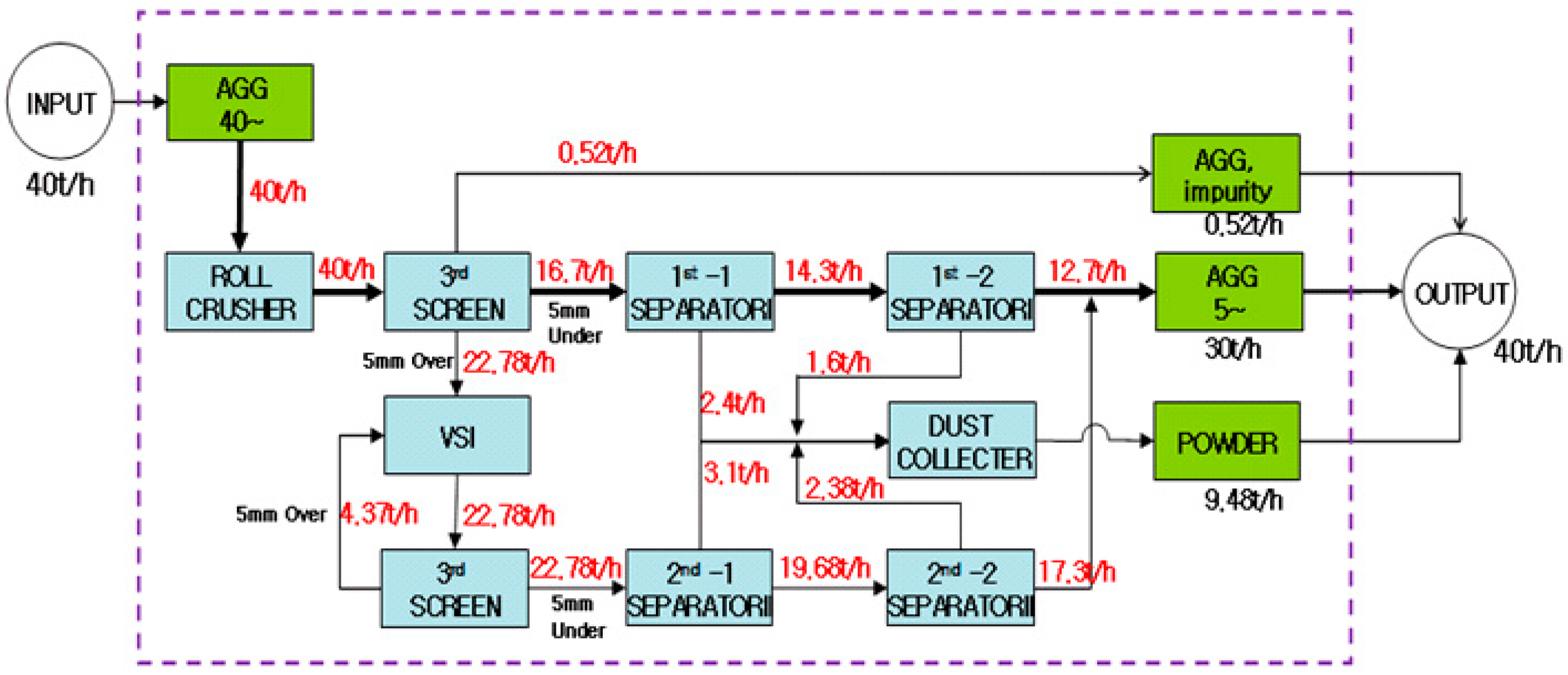
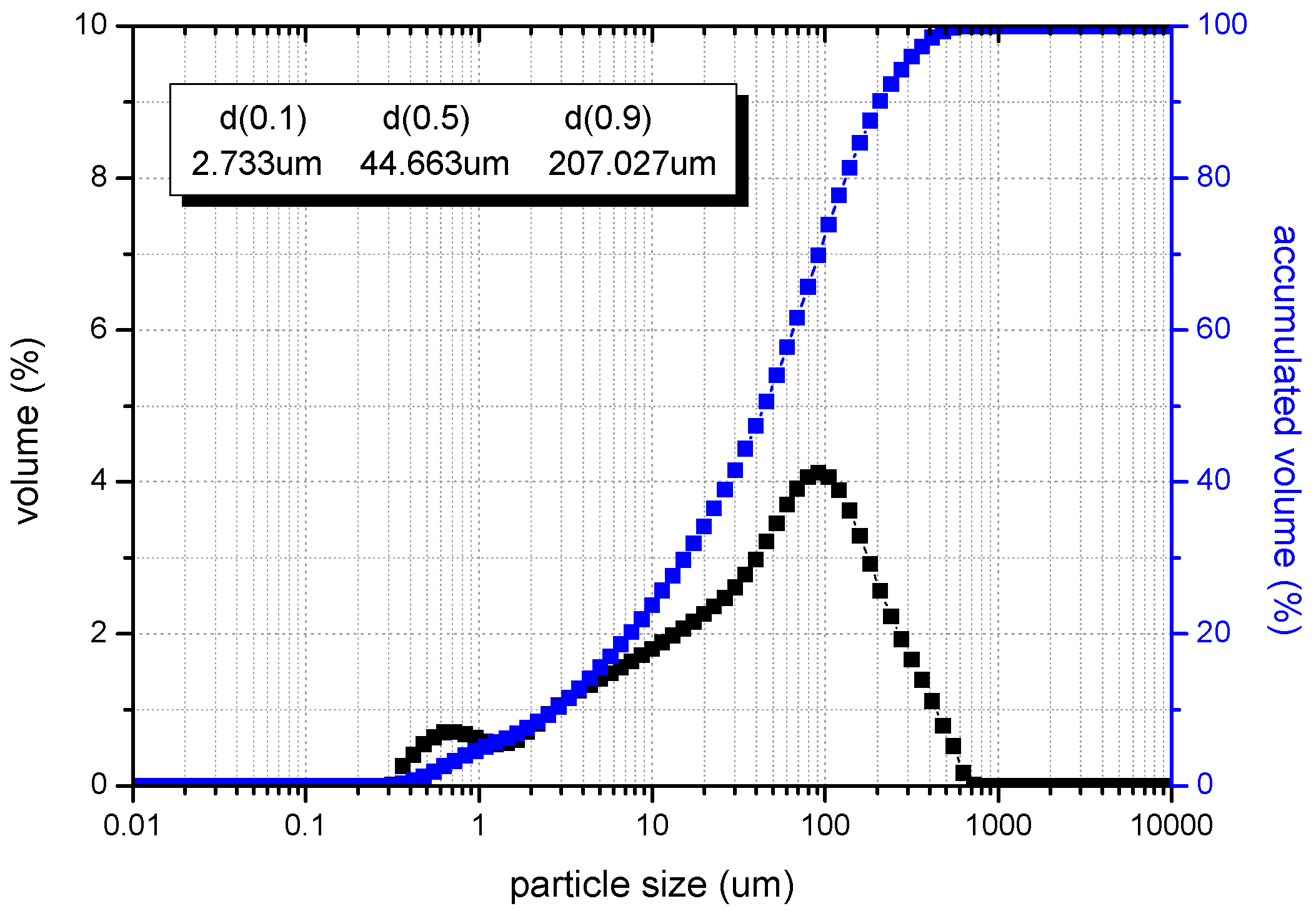
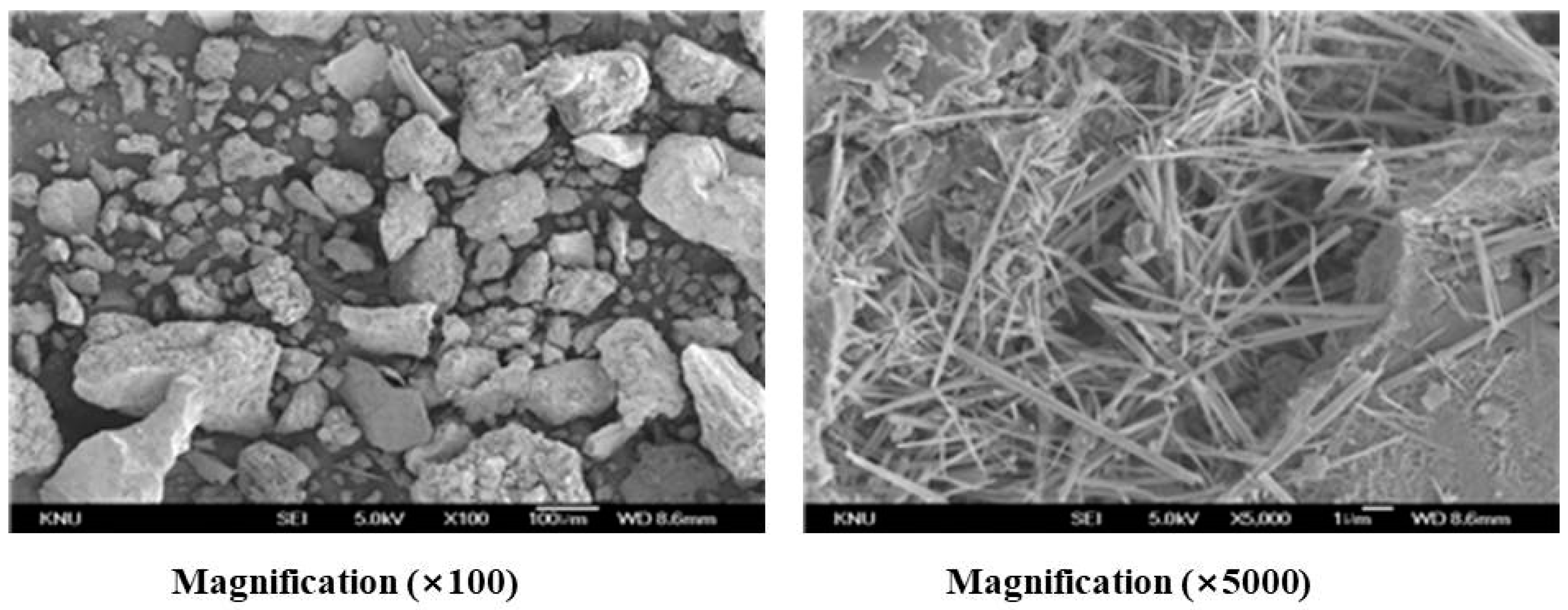
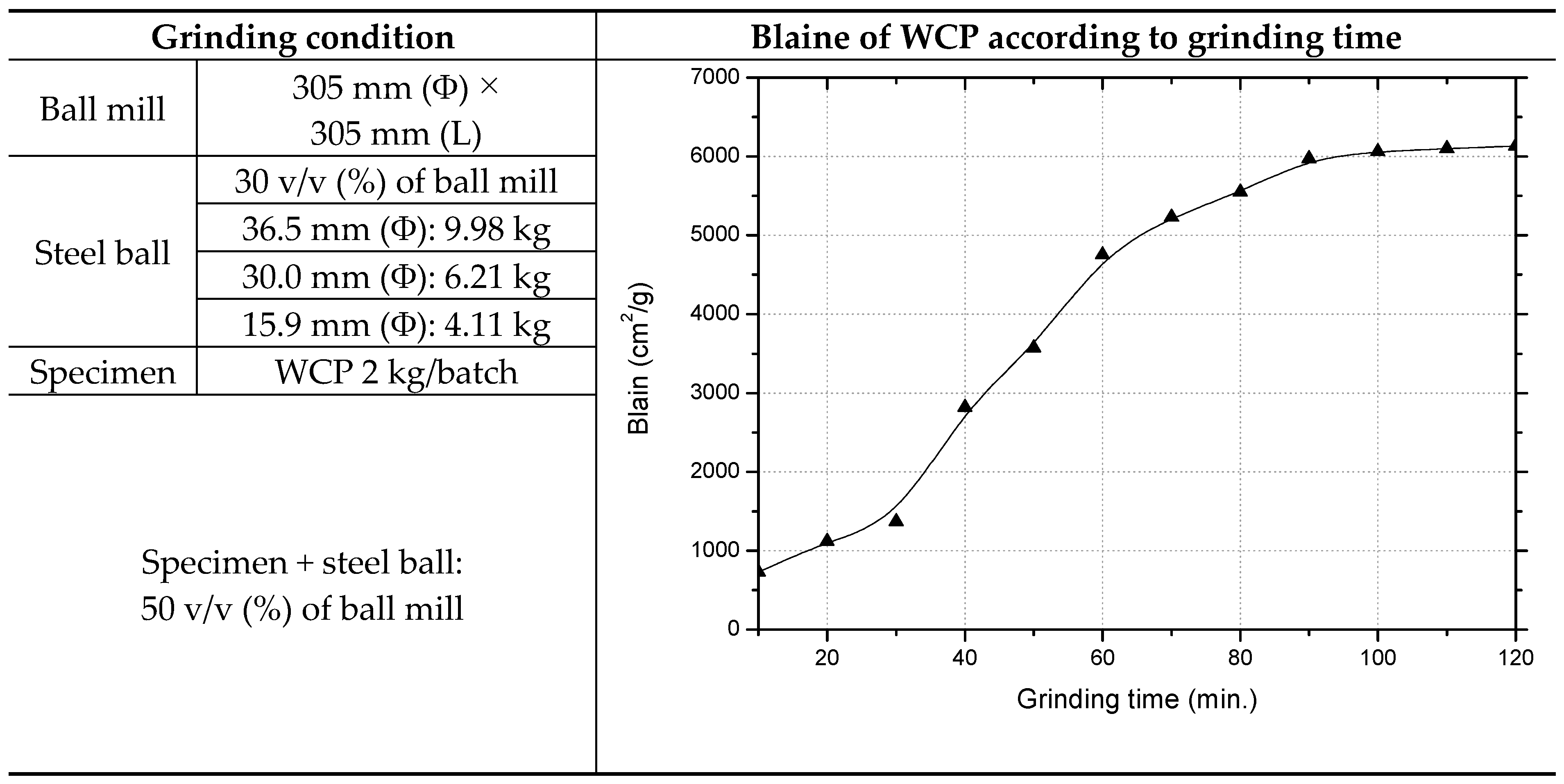
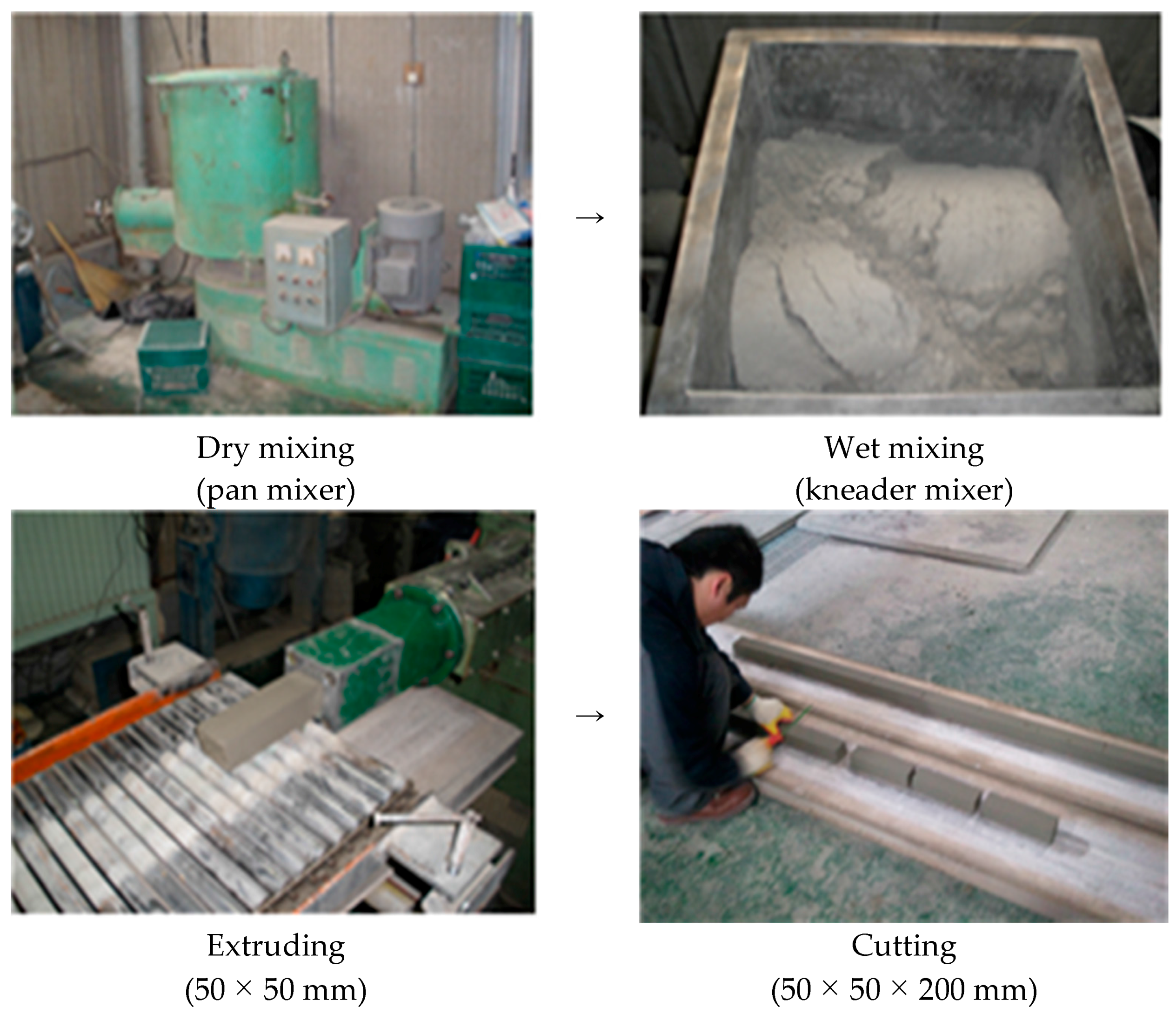
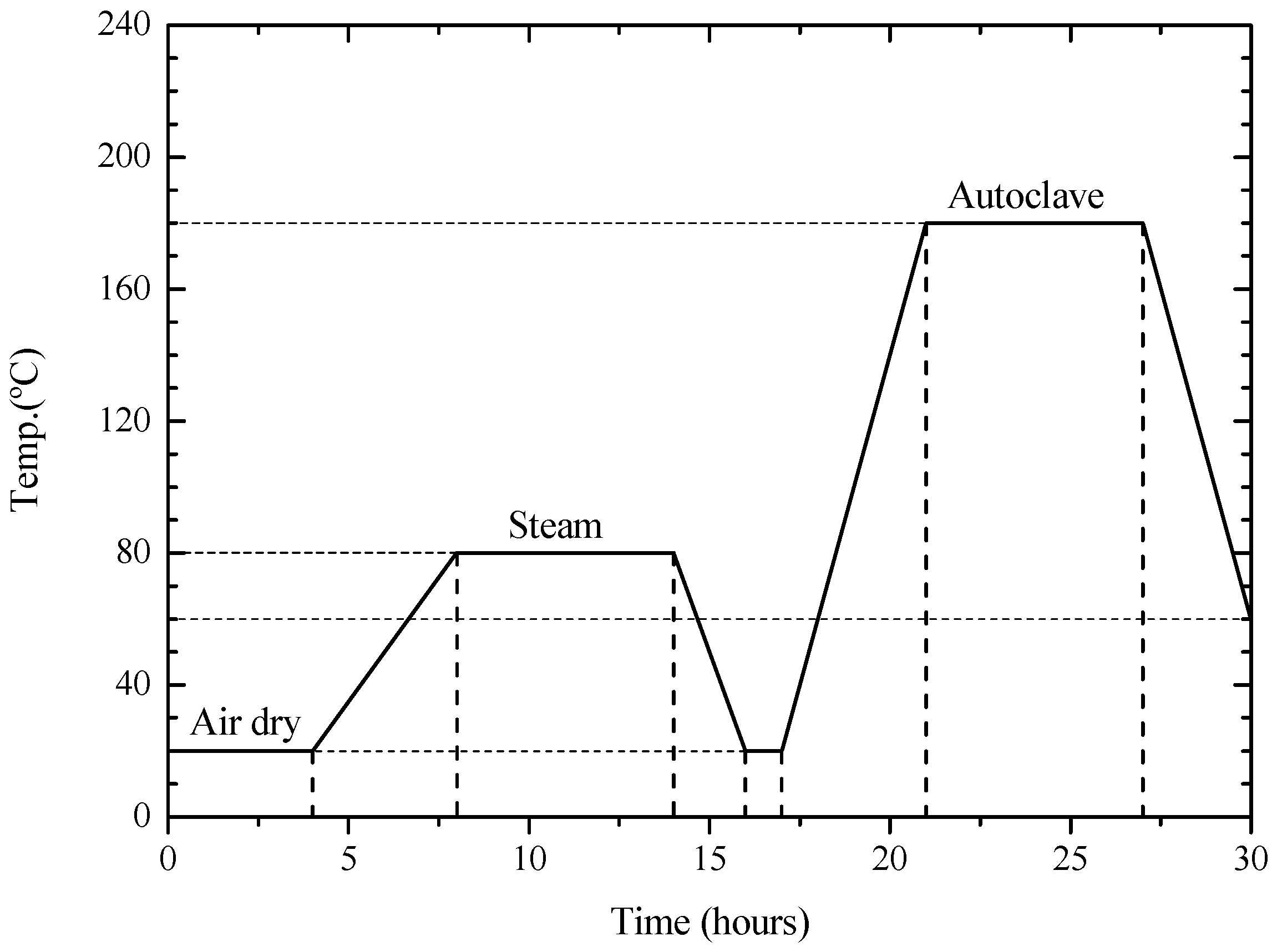
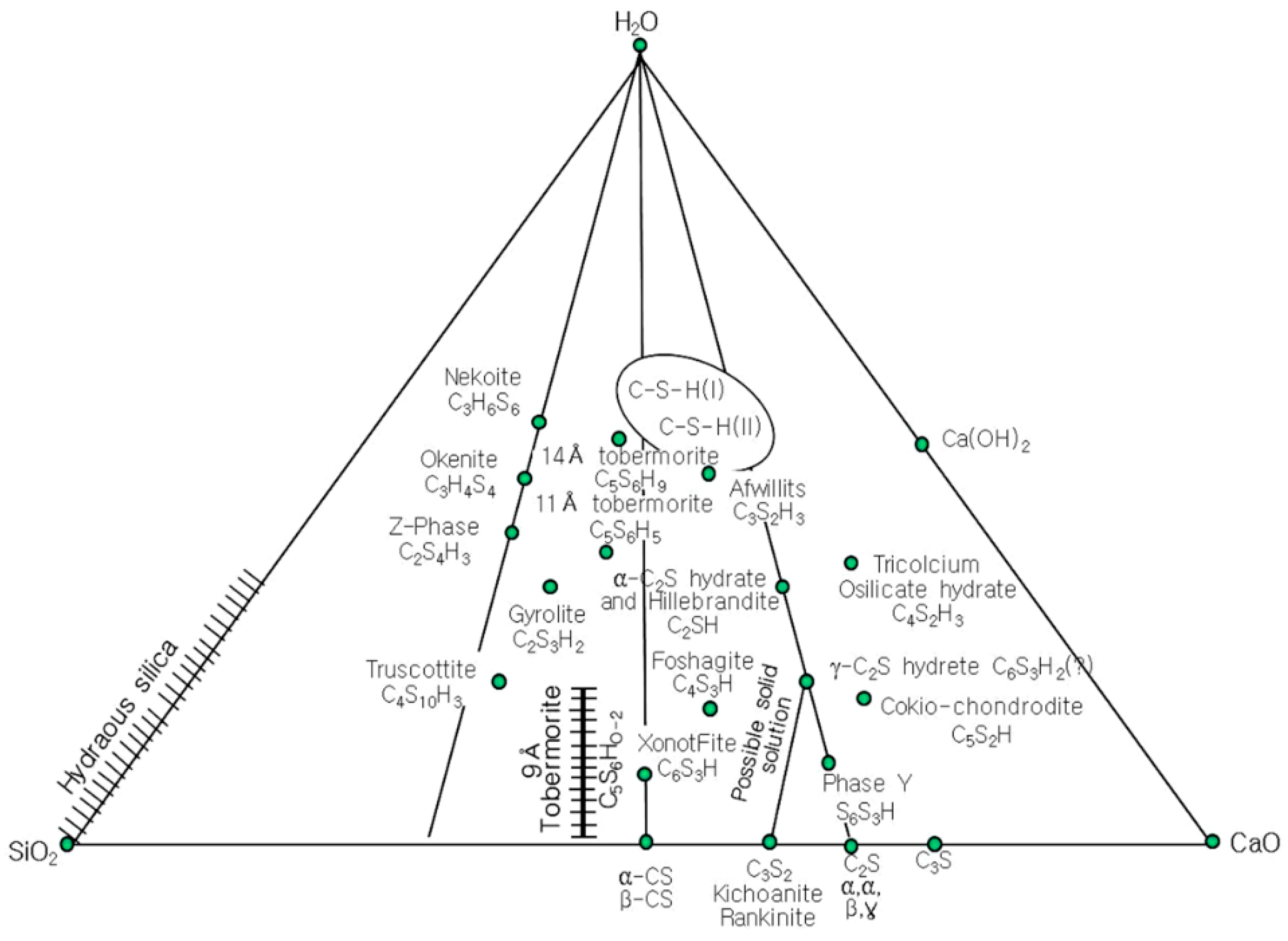
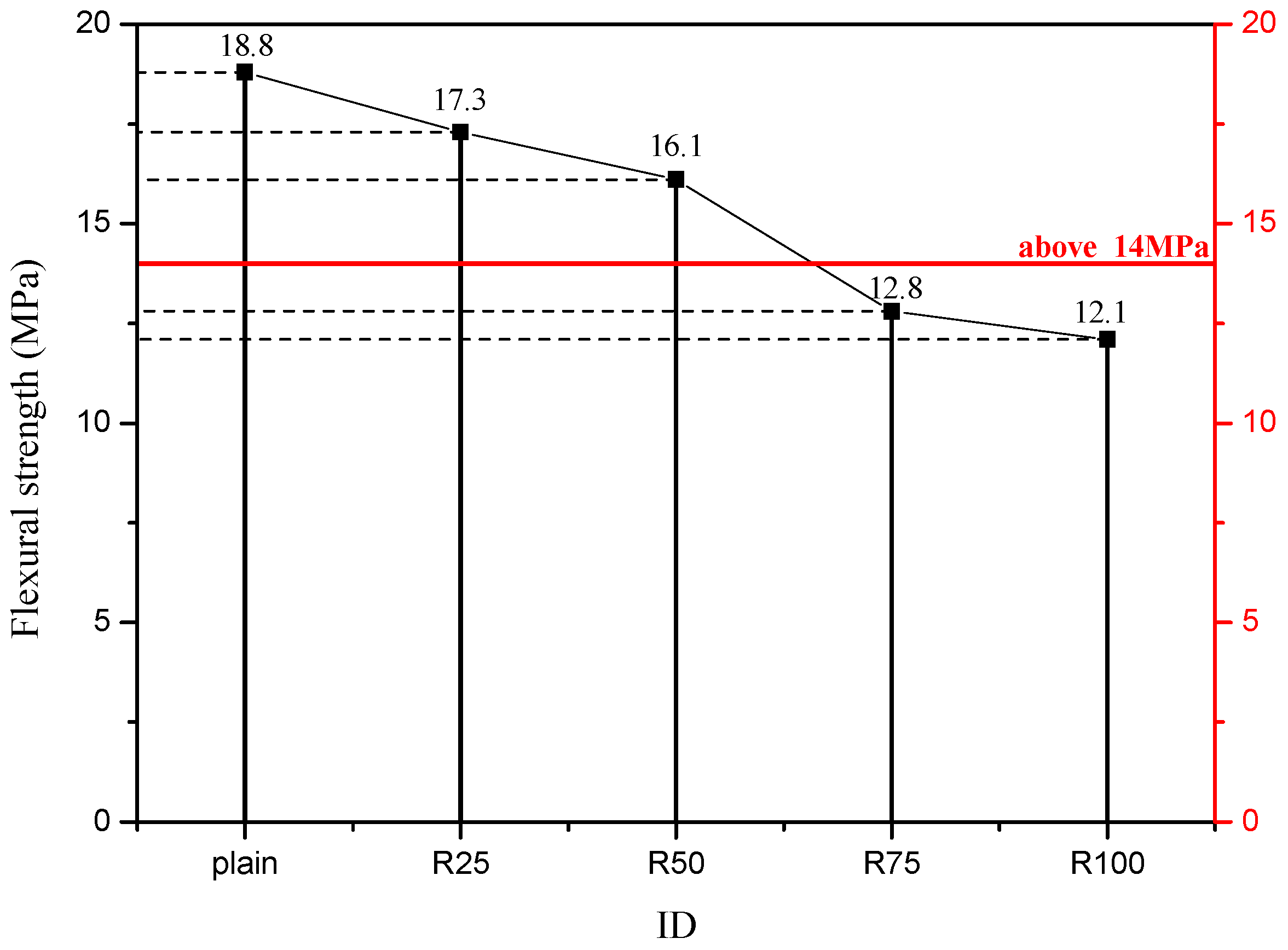
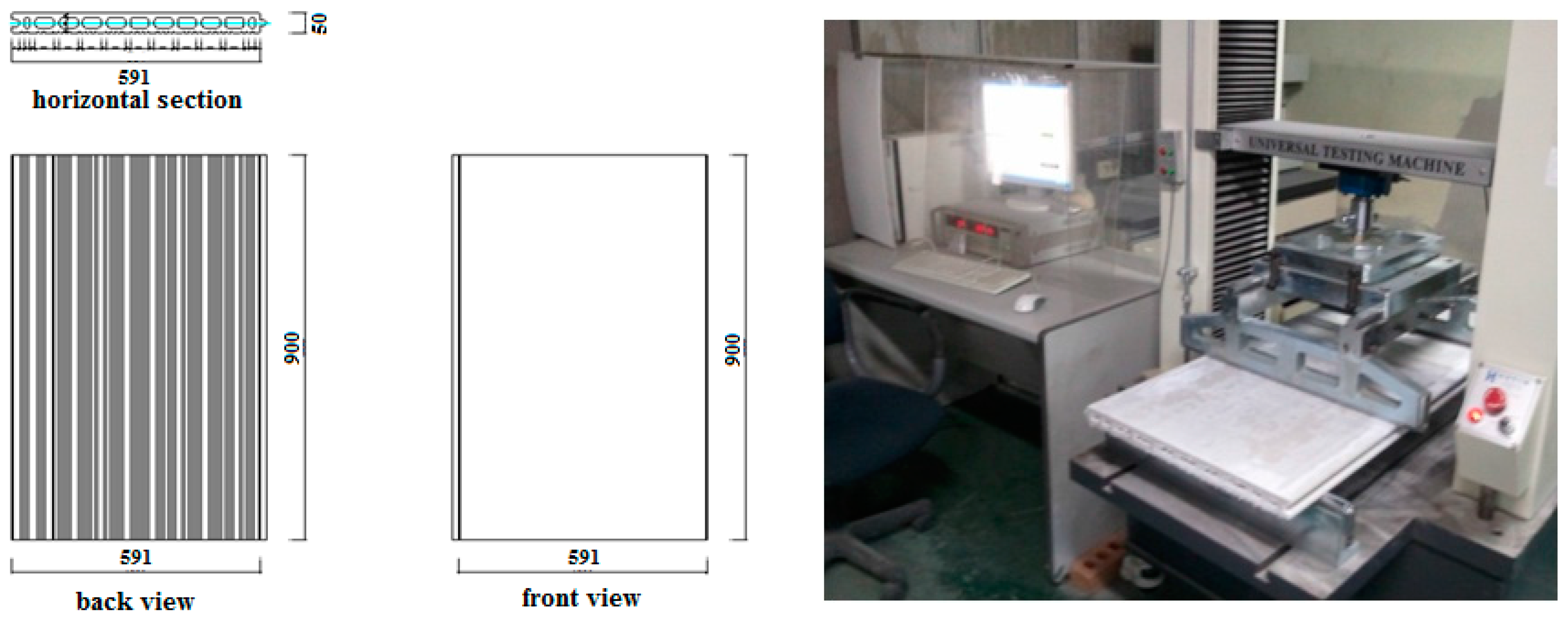
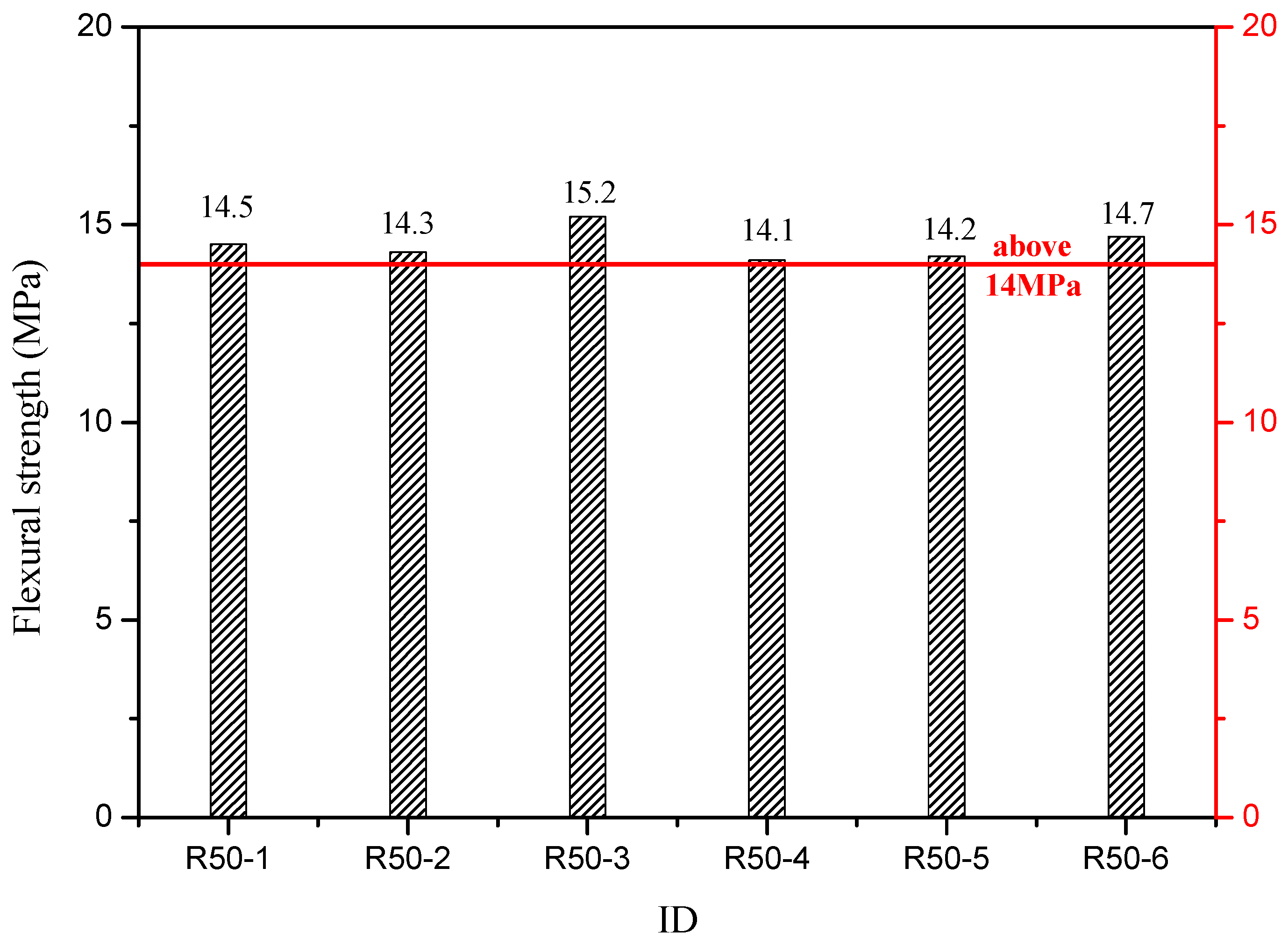
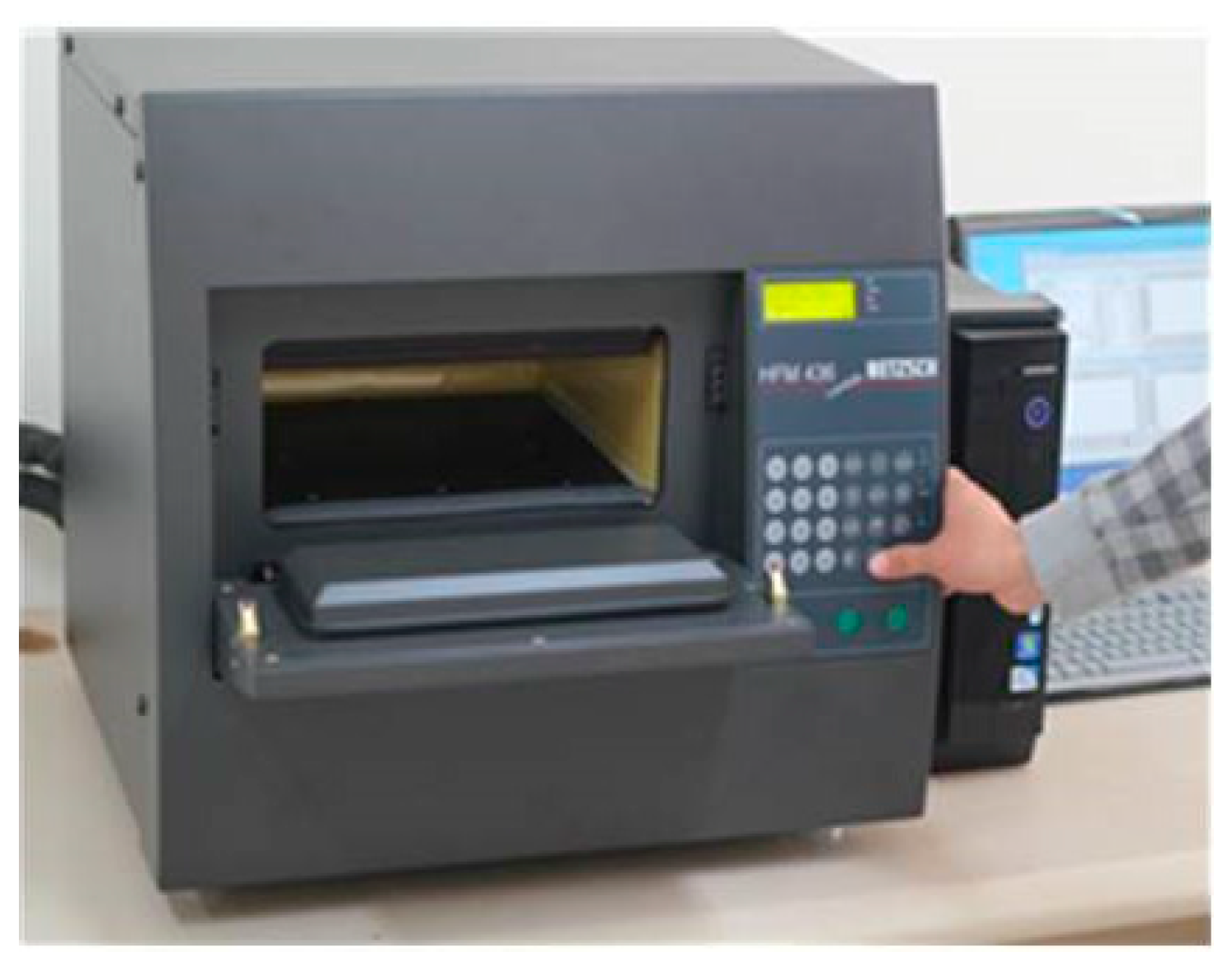

| Factors | Levels | Test Items |
|---|---|---|
| Aggregate | Silica powder WCP * | Flexural strength Specific density Absorption ratio Length change Thermal conductivity Fire-resistance |
| Replacement ratio (wt %) | 0, 25, 50, 75, 100 |
| Density (g/cm3) | Blaine (cm2/g) | Setting Time | ||||||||
|---|---|---|---|---|---|---|---|---|---|---|
| Start (min) | Finish (min) | |||||||||
| 3.15 | 3240 | 290 | 380 | |||||||
| Chemical composition (%) | ||||||||||
| LOI | SiO2 | Al2O3 | Fe2O3 | CaO | MgO | SO3 | K2O | |||
| 0.35 | 21.88 | 5.02 | 3.66 | 64.18 | 2.01 | 1.83 | 0.92 | |||
| Chemical Composition (wt %) | Density (g/cm3) | Blaine (cm2/g) | |||||||
|---|---|---|---|---|---|---|---|---|---|
| LOI | SiO2 | CaO | Fe2O3 | Al2O3 | K2O | SO3 | |||
| WCP | 2.8 | 31.8 | 39.0 | 10.5 | 7.4 | 4.7 | 3.5 | 2.60 | <1000 |
| Silica powder | 1.7 | 95.5 | - | 0.7 | 1.9 | - | - | 2.66 | 4160 |
| Unit Weight (kg/m3) | ||||||||
|---|---|---|---|---|---|---|---|---|
| ID | Binder | Fiber | Wollastonite | HPMC * | Water | |||
| Cement | Silica Powder | WCP | Sepiolite | Pulp | ||||
| Plain | 604.2 | 604.2 | 0.0 | 9.1 | 22.7 | 37.8 | 8.3 | 490.9 |
| R *25 | 595.5 | 446.6 | 148.9 | 9.0 | 22.6 | 37.6 | 8.3 | 488.5 |
| R50 | 598.4 | 299.2 | 299.2 | 9.0 | 22.4 | 37.4 | 8.2 | 486.1 |
| R75 | 595.5 | 148.9 | 446.6 | 8.9 | 22.3 | 37.2 | 8.2 | 483.9 |
| R100 | 592.7 | 0.0 | 592.7 | 8.9 | 22.2 | 37.0 | 8.1 | 481.5 |
| Test Type | Curing Level | Replacement Ratio (%) | ||||
|---|---|---|---|---|---|---|
| Plain | 25 | 50 | 75 | 100 | ||
| Specific gravity (g/cm3) Below 2.0 | Air-dry | 1.90 | 1.95 | 1.97 | 1.99 | 1.99 |
| Steam | 1.72 | 1.76 | 1.81 | 1.89 | 1.92 | |
| Autoclave | 1.71 | 1.74 | 1.75 | 1.75 | 1.78 | |
| Absorption rate (%) Below 18 | Air-dry | 6.52 | 6.65 | 7.18 | 7.15 | 9.20 |
| Steam | 8.87 | 9.02 | 9.24 | 9.68 | 14.14 | |
| Autoclave | 12.03 | 11.97 | 12.11 | 12.31 | 14.69 | |
| Length change (%) Below 0.12 | Air-dry | 0.32 | 0.33 | 0.32 | 0.24 | 0.27 |
| Steam | 0.19 | 0.19 | 0.17 | 0.12 | 0.13 | |
| Autoclave | 0.07 | 0.06 | 0.07 | 0.07 | 0.10 | |
| Type | No. | Test Time | Mean T (°C) | Delta T (°C) | Thermal Conductivity (W/m·K) | Termal Gradient (m2·K/W) |
|---|---|---|---|---|---|---|
| Plain | 1 | 0:50:35 | 25.67 | 20.15 | 0.302063 | 0.157386 |
| 2 | 0:21:01 | 25.93 | 20.10 | 0.302105 | 0.157365 | |
| 3 | 0:21:02 | 26.05 | 20.08 | 0.302220 | 0.157304 | |
| 4 | 0:56:44 | 25.73 | 20.00 | 0.324385 | 0.146319 | |
| 5 | 0:21:01 | 25.96 | 19.96 | 0.322547 | 0.147152 | |
| 6 | 0:21:02 | 26.07 | 19.94 | 0.321748 | 0.147518 | |
| R50 | 1 | 0:55:06 | 25.79 | 19.98 | 0.334488 | 0.142052 |
| 2 | 0:21:02 | 26.01 | 19.95 | 0.332706 | 0.142813 | |
| 3 | 0:21:02 | 26.11 | 19.93 | 0.332077 | 0.143083 | |
| 4 | 0:58:17 | 25.85 | 20.18 | 0.297308 | 0.160590 | |
| 5 | 0:21:02 | 26.02 | 20.15 | 0.295605 | 0.161516 | |
| 6 | 0:21:02 | 26.10 | 20.13 | 0.294910 | 0.161896 |
| Test Items | Performance Criteria | Test Result Plain/(R50) | Fire Resistance Plain/(R50) | ||
|---|---|---|---|---|---|
| Flame interruption performance | Penetration of crack gauge | N/A (N/A) | 120 min (120 min) | 32 min (34 min) | |
| Ignition of pads surface | N/A (N/A) | 120 min (120 min) | |||
| Occurrence of flame (10 s and over) | N/A (N/A) | 120 min (120 min) | |||
| Thermal interruption performance | Initial Temp. | - | Mean 21 °C (Mean 21 °C) | - | |
| Mean temp. (non-heating surface) | 161 °C | 163 °C (162 °C) | 33 min (35 min) | ||
| Max temp. (non-heating surface) | 201 °C | 206 °C (209 °C) | 42 min (43 min) | ||
| Portable thermocouple | - | - | - | ||
© 2017 by the authors. Licensee MDPI, Basel, Switzerland. This article is an open access article distributed under the terms and conditions of the Creative Commons Attribution (CC BY) license (http://creativecommons.org/licenses/by/4.0/).
Share and Cite
Kim, H.-S.; Lee, S.-H.; Kim, B. Properties of Extrusion Concrete Panel Using Waste Concrete Powder. Appl. Sci. 2017, 7, 910. https://doi.org/10.3390/app7090910
Kim H-S, Lee S-H, Kim B. Properties of Extrusion Concrete Panel Using Waste Concrete Powder. Applied Sciences. 2017; 7(9):910. https://doi.org/10.3390/app7090910
Chicago/Turabian StyleKim, Ha-Seog, Sea-Hyun Lee, and Byoungil Kim. 2017. "Properties of Extrusion Concrete Panel Using Waste Concrete Powder" Applied Sciences 7, no. 9: 910. https://doi.org/10.3390/app7090910
APA StyleKim, H.-S., Lee, S.-H., & Kim, B. (2017). Properties of Extrusion Concrete Panel Using Waste Concrete Powder. Applied Sciences, 7(9), 910. https://doi.org/10.3390/app7090910





